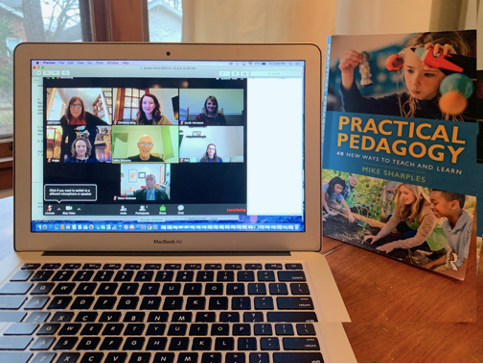 by Sarah Hampton
by Sarah Hampton
Last January, we were lucky enough to have a conversation with Mike Sharples, the author of Practical Pedagogy 40 New Ways to Teach and Learn, 1st Edition. While we apologize for the delay in posting — we got a little busy with transitioning to remote and hybrid teaching — we think that pedagogy is more important than ever and want to share some timely insights from the conversation. This is the first of a series of posts and is a little about math and a lot about pedagogy. If you’re here for the pedagogy but not the math, just stick with us past the example from my own math teaching journey.
I’ve always liked math as a subject, but as a student math class was never my favorite. Every year, math class went something like this.
- I showed up for class.
- I took out my home work and we reviewed it.
- My teacher would go over questions.
- I’d sit and listen to a lecture while I took notes.
- I tried a few guided practice questions.
- I went home and did my homework.
- Wash, rinse, repeat.
When I accidentally fell into teaching math, that was all I had ever known so that’s how I taught, too. Fortunately, a few years into teaching, I was introduced to a professional development program specifically for math teachers hosted by a local college. The program professors allowed me to experience a different kind of math classroom! I learned new concepts by exploring first, then reflecting and articulating my nascient thoughts and defending my reasoning. In fact, the entire process was accomplished by me, the learner. That’s not to say that the professors were absent or that their roles weren’t important. They…
- created the learning environment and tasks
- motivated me
- intervened at critical moments
- prodded me to reflect and refine my thoughts
- helped me internalize the learning.
This experience changed how I thought math class could look. That summer, I fully understood that how we teach is just as important as what we teach. In other words, pedagogy really matters.
We all use pedagogies every day, but it may be something we do unintentionally. Take a minute to think about your “go to” approach to teaching and learning. What happens on a typical day in your classroom? Maybe you’re likely to teach through lectures followed by guided practice. Maybe you facilitate class-wide conversations about your content. Maybe you organize your classroom into pods of students (or breakout rooms these days!) for collaborative learning.
Something to consider–no matter what you typically do, that teaching approach is well-suited for some types of learning goals but ineffective for others. You know the typical math classroom I talked about in the beginning of the post? That’s a type of direct instruction pedagogy. In fact, parts of it are really effective for some things. For one, teachers can disseminate information quickly. For another, it’s great when students have very little prior knowledge about a topic. Unfortunately, this pedagogy is not the most effective for things like long-term retention or transfer. By contrast, constructivist pedagogies like those used by the program professors are effective for deep learning, motivation, and engagement. (You can read more constructivist pedagogies in three previous posts–Learning Scientists and Classroom Practice, Practitioner POV of Constructivist Approaches, and The Benefits and Obstacles of Constructivism.)
Too often, we get stuck in a pedagogical rut and force our daily learning goals to fit our routine teaching style. Instead, we need to start purposefully thinking about which pedagogies best support our daily goals. In this series, I want to draw your attention to the pedagogies you use and introduce you to some you may not be familiar with so you can expand your teaching toolkit.
Teaching should be about meeting students where they are, and different pedagogies help us reach different students at different points in their learning journeys. The more learning theory and instructional strategies we understand, the more intentional we can be about selecting approaches that engage more of our students and meet their needs.
The more pedagogies we know → the more we can choose from → the more targeted we can make the approach to hit the learning goals → the better our students can learn
How often do you change up your pedagogies? When are you most likely to make changes to your pedagogies? Are you in a teaching rut now? Think about the best teacher you’ve ever had. What pedagogies did that teacher use?
In the next post, we’ll look at the role of pedagogy when teaching with technology and how we can use different pedagogies to up our pandemic teaching game. If necessity is the mother of invention, then learning about different pedagogies is more important now than ever. You don’t have to be an expert in a new pedagogy to use it in your classroom. I hope you find one that you are excited to try!
Related Resources:
Innovating Pedagogy 2021
Innovating Pedagogy website with links to all Open University Innovation Reports
Mike Sharples Keynote at Cyberlearning 2019
What do you think? Let us know @EducatorCIRCLS.
This post is part of the Practical Pedagogy Series
In Educator CIRCLS, we’ve been doing the messy, fun, and challenging work of learning through discussions of our reading of Practical Pedagogy 40 New Ways to Teach and Learn, 1st Edition. We were lucky enough to have a conversation with Mike Sharples, the author. We feel we are emerging from those conversations as more informed and effective educators! We would love you to share your thoughts and join the conversation.
Educator CIRCLS posts are licensed under a Creative Commons Attribution 4.0 International License. If you use content from this site, please cite the post and consider adding: “Used under a Creative Commons Attribution 4.0 International License (http://creativecommons.org/licenses/by/4.0/).”
Suggested citation format: [Authors] ([Year]). [Title]. Educator CIRCLS Blog. Retrieved from [URL]

